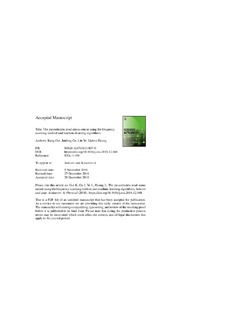| dc.contributor.author | Gui, kang | |
| dc.contributor.author | Ge, Junfeng | |
| dc.contributor.author | Ye, Lin | |
| dc.contributor.author | Huang, Lizhen | |
| dc.date.accessioned | 2020-01-14T08:06:50Z | |
| dc.date.available | 2020-01-14T08:06:50Z | |
| dc.date.created | 2019-01-22T08:50:28Z | |
| dc.date.issued | 2019 | |
| dc.identifier.citation | Sensors and Actuators A-Physical. 2019, (287), 8-20. | nb_NO |
| dc.identifier.issn | 0924-4247 | |
| dc.identifier.uri | http://hdl.handle.net/11250/2636055 | |
| dc.description.abstract | This paper introduces a piezoelectric sensor for measuring the thickness of ice and water film on road surfaces, utilizing the frequency scanning method and machine-learning algorithms. With a constant elasticity alloy plate and a three-electrode piezoelectric transducer disc, this sensor detects ice and water by vibrating. During the research, a model of elastic thin plate with small deflections was built to describe the sensor’s vibration characteristics and the sensing unit’s amplitude frequency response curves of different ice and water film thickness were recorded. The curves show a high correlation between the thickness of loads and the curve shapes. In order to expand the measurement range, 425 sets featuring vectors for the machine-learning model were extracted, and some specific features such as median, variance, area, centroid and energy under the curves were utilized. The performance of conventional methods and two regression models based on support vector regression (SVR) and an artificial neural network (ANN) were evaluated with cross-validation results. The measurement range of the sensor turned out to be 0–10 mm. Based on the ANN model, on an average 85.5% and 100% of the neural network outputs had a regression error less than 0.5 mm and 1.0 mm respectively. Finally, the result of an 18-day field test on the roads of the Norwegian University of Science and Technology is presented. | nb_NO |
| dc.language.iso | eng | nb_NO |
| dc.publisher | Elsevier | nb_NO |
| dc.rights | Attribution-NonCommercial-NoDerivatives 4.0 Internasjonal | * |
| dc.rights.uri | http://creativecommons.org/licenses/by-nc-nd/4.0/deed.no | * |
| dc.title | The piezoelectric road status sensor using the frequency scanning method and machine-learning algorithms | nb_NO |
| dc.type | Journal article | nb_NO |
| dc.type | Peer reviewed | nb_NO |
| dc.description.version | acceptedVersion | nb_NO |
| dc.source.pagenumber | 8-20 | nb_NO |
| dc.source.journal | Sensors and Actuators A-Physical | nb_NO |
| dc.source.issue | 287 | nb_NO |
| dc.identifier.doi | 10.1016/j.sna.2018.12.048 | |
| dc.identifier.cristin | 1662614 | |
| dc.description.localcode | © 2018. This is the authors’ accepted and refereed manuscript to the article. Locked until 30.12.2020 due to copyright restrictions. This manuscript version is made available under the CC-BY-NC-ND 4.0 license http://creativecommons.org/licenses/by-nc-nd/4.0/ | nb_NO |
| cristin.unitcode | 194,63,10,0 | |
| cristin.unitcode | 194,64,94,0 | |
| cristin.unitname | Institutt for datateknologi og informatikk | |
| cristin.unitname | Institutt for vareproduksjon og byggteknikk | |
| cristin.ispublished | true | |
| cristin.fulltext | postprint | |
| cristin.qualitycode | 1 | |

